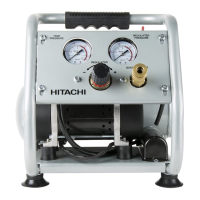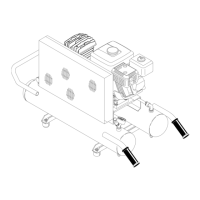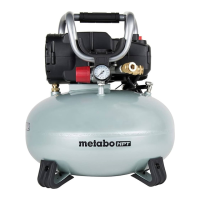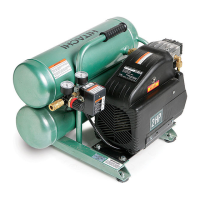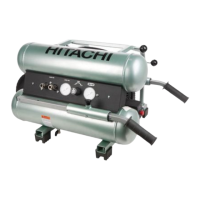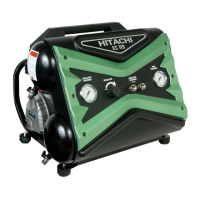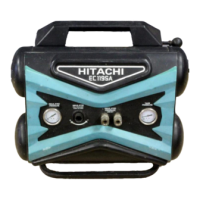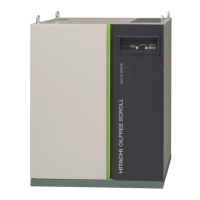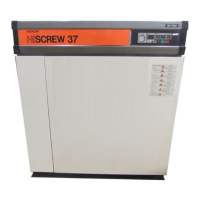English
— 9 —
2. Location
WARNING: In order to avoid damaging this
compressor, do not incline this
compressor transversally or
longitudinally more than 10°.
Place this compressor at least 4 inches (10 cm) away
from obstacles that may prevent proper ventilation. Do
not place this compressor in an area:
- where there is evidence of oil or gas leaks.
- where fl ammable gas vapors or materials may be
present.
- where air temperatures fall below 32°F (0
°C) or
exceed 95°F (35
°C).
- where extremely dirty air or water could be drawn into
this compressor.
CAUTION:
When operating or storing the compressor,
set 4 rubber bumpers downward on the
fl oor (Refer to Fig. 1).
Excessive vibration is a major cause of
premature compressor failure.
Always maintain the rubber bumper located
beneath tank.
3. Gasoline engine
A) Review page 6. 27 before fueling.
WARNING:
Do not allow the engine or muffl er
to come in contact with fl ammable
vapors, combustible dust, gases
or other combustible materials. A
spark may cause a fi re. Do not place
this compressor in an area where
fl ammable gas vapors may be present.
B) Read the engine manual accompanying this
compressor for correct engine start-up maintenance
procedures.
C) Read and understand the safety labels located on
this compressor.
D) A minimum of 85 octane fuel is recommended
for use with this compressor. Do not mix oil with
gasoline.
E) Use of clean, fresh, lead free gasoline should be
used. Do not use gasoline containing methanol or
alcohol.
F) Check the engine oil level before starting (See
engine manual).
G) Fill the fuel tank according to the engine manual
instructions.
WARNING:
Follow all fueling instructions in
operator’s manual. Gasoline is
extremely fl ammable, and gasoline
vapor can explode. Do not refuel
fuel tank while this compressor
is running or hot. Never smoke
near gasoline, and keep other
fl ames and sparks away. Allow this
compressor and engine to cool
down before refueling. Do not refuel
indoors or in a poorly ventilated
area. Do not fi ll fuel tank to point of
overfl owing. Always refuel slowly
to avoid the possibility of spilled
fuel which may cause a fi re. Do not
operate this compressor if gasoline
is spilled. Wipe this compressor
clean and move it away from the
spill. Avoid creating any ignition
until the gasoline has evaporated.
Allow approximately 1/4” (6 mm)
of tank space for fuel expansion.
Always store fuel away from this
compressor while it is running or
hot. Always store gasoline in an
approved container.
H) Refer to the engine manual for all necessary
maintenance and adjustments.
WARNING:
Do not operate this compressor in an
enclosed area. Use this compressor
only in well ventilated areas. The
exhaust from the engine contains
carbon monoxide, a poisonous,
odorless and invisible gas. Breathing
the gas can cause serious injury,
illness and possible death. Avoid
inhalation of exhaust gas. Never
run the engine in a closed garage or
confi ned area.
4. Air coupler installation
Screw in the air coupler to the joint (Refer to Fig.1 and
Fig.5). The screw size of the joint is 3/8”. Use an air
coupler which has the same screw size.
5. Pre-start checklist
A) Make sure the engine switch is in the “OFF” position.
B) Remove any moisture in this compressor air tank.
Gradually open the drain cock and discharge the
drain. Close tightly when drained.
C)
Make sure the safety valve is working correctly (refer
to Fig.1). The safety valve is designed to prevent
system failures by relieving pressure from the system
when this compressed air reaches a predetermined
level. The safety valve is preset by the manufacturer
and must not be modifi ed in any way.
Before starting the compressor, pull the ring on
the safety valve to make sure that the safety
valve operates smoothly. (Fig. 7) Do not use the
compressor if the safety valve is stuck or does not
operate smoothly. Have the defective safety valve
replaced by a Hitachi authorized service center.
Safety valve
Fig. 7
WARNING: Drain tank to release air pressure
before pull the ring on the safety
valve.
000BookEC2610Elowes.indb9000BookEC2610Elowes.indb9 2018/03/0910:24:512018/03/0910:24:51
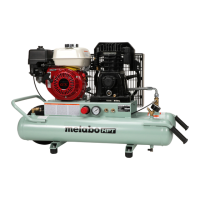
